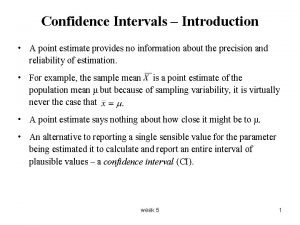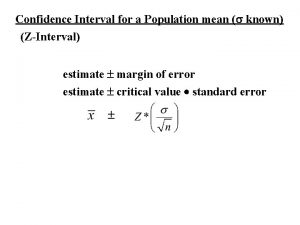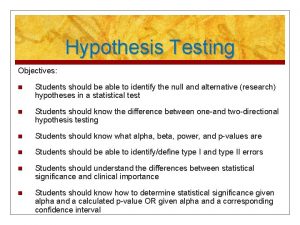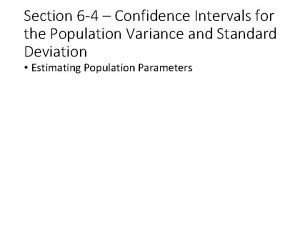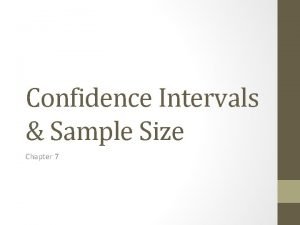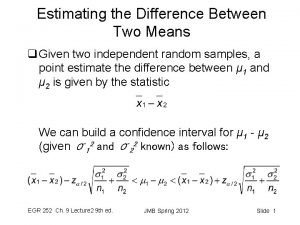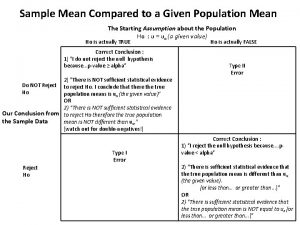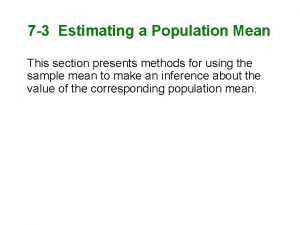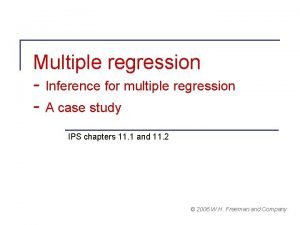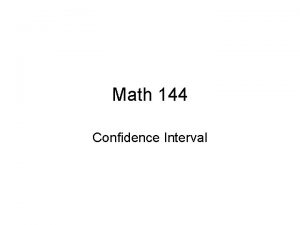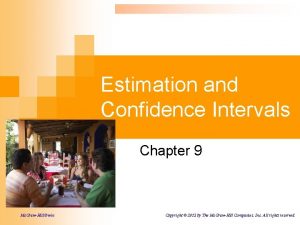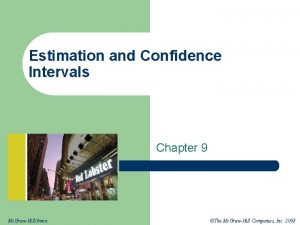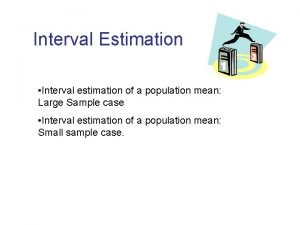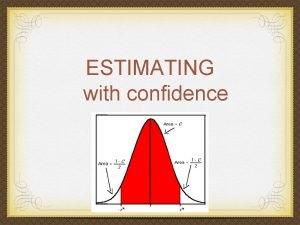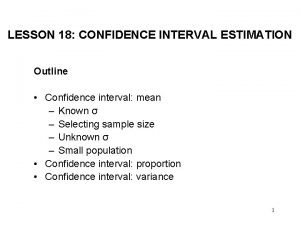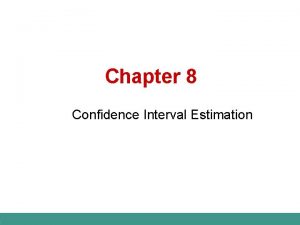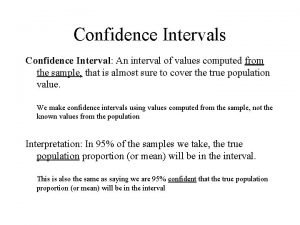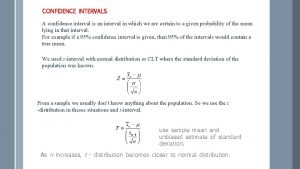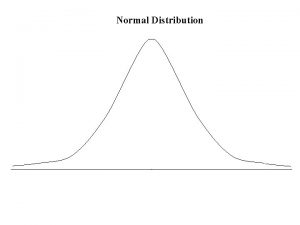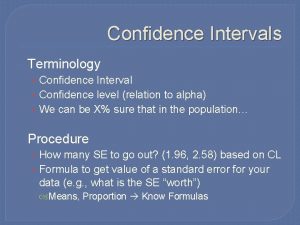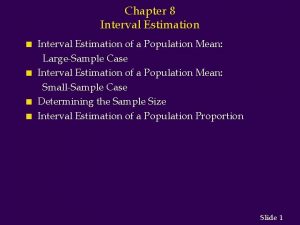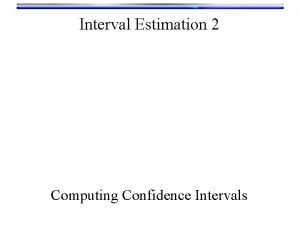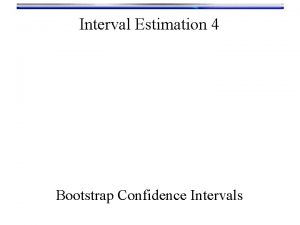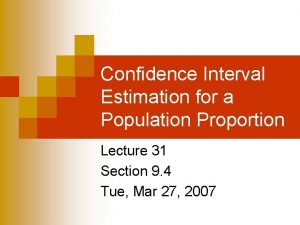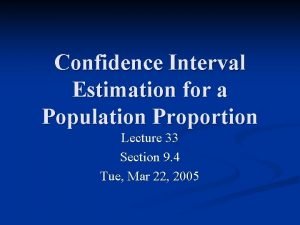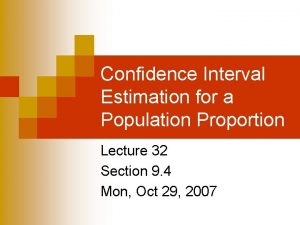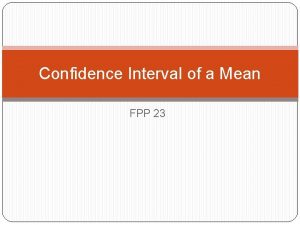Confidence Interval Estimation for a Population Mean Lecture


















- Slides: 18

Confidence Interval Estimation for a Population Mean Lecture 36 Section 10. 4 Wed, Apr 4, 2007

Confidence Intervals To estimate , we will use confidence intervals, as we did when estimating p. n The basic form, as well as theory, is the same as before: (pt. est. ) (appropriate no. of st. devs. ) n

Confidence Intervals What is the point estimate for ? n What is the standard deviation for this estimator? n How do we determine the appropriate number of standard deviations? n

Confidence Intervals n The confidence interval will be or or

When to Use Z n If ¨ The population is normal (or nearly normal) and is known, or ¨ The population is not normal, but the sample size is at least 30, n Then use Z.

When to Use t n If ¨ The population is normal (or nearly normal), and ¨ is not known, n Then use t.

Example n n Example 10. 4, p. 641. Construct a 95% confidence interval for the true mean weight of such boxes.

Example Use Z. Why? n n = 25. n x = 9. 82. n Assume that = 0. 29. (Why? ) n Level of confidence = 95%, so z = 1. 96. n

Example n The confidence interval is 9. 82 (1. 96)(0. 29/ 25) = 9. 82 0. 114 = (9. 706, 9. 934).

TI-83 – Confidence Intervals When the standard normal distribution applies, do the following. n Press STAT. n Select TESTS. n Select ZInterval. n A window appears requesting information. n

TI-83 – Confidence Intervals Select Data or Stats. n Assume we selected Stats. n Enter x. n Enter n. n Enter the level of confidence. n Select Calculate and press ENTER. n

TI-83 – Confidence Intervals A window appears containing n The title “ZInterval”. n The confidence interval in interval notation. n The sample mean. n The sample size. n

Example n n Example 10. 5, p. 643. Construct a 99% confidence interval for the mean number of unoccupied seats.

Example Should we use Z or t? Why? n n = 61. n x = 12. 6. n s = 4. 4. n Level of confidence = 99%. Find t. n

Example n The confidence interval is 12. 6 (2. 660)(4. 4/ 61) = 12. 6 1. 499 = (11. 101, 14. 099).

TI-83 – Confidence Intervals To use t, do the following. n Press STAT. n Select TESTS. n Select TInterval. n A window appears requesting information. n

TI-83 – Confidence Intervals Select Data or Stats. n Assume we selected Stats. n Enter x. n Enter s. n Enter n. n Enter the level of confidence. n Select Calculate and press ENTER. n

TI-83 – Confidence Intervals A window appears containing n The title “TInterval”. n The confidence interval in interval notation. n The sample mean. n The sample standard deviation. n The sample size. n
 96 confidence interval z score
96 confidence interval z score Confidence interval for population mean
Confidence interval for population mean Zinterval
Zinterval Confidence interval vs confidence level
Confidence interval vs confidence level Confidence interval vs confidence level
Confidence interval vs confidence level Confidence interval for population variance formula
Confidence interval for population variance formula Confidence interval formula sample mean
Confidence interval formula sample mean Confidence interval for mean
Confidence interval for mean Sample mean and population mean
Sample mean and population mean Population mean example
Population mean example Confidence interval formula
Confidence interval formula Confidence interval econometrics
Confidence interval econometrics Confidence interval multiple regression
Confidence interval multiple regression Confidence interval for variance
Confidence interval for variance 96 percent confidence interval
96 percent confidence interval 96 percent confidence interval
96 percent confidence interval 95 percent confidence interval
95 percent confidence interval Confidence interval formula proportion
Confidence interval formula proportion How to find critical t value
How to find critical t value

